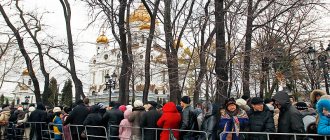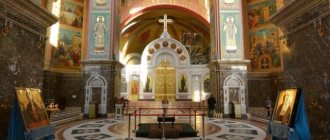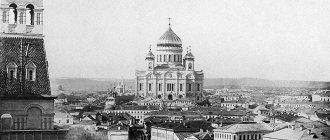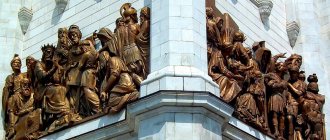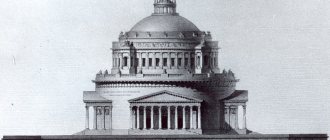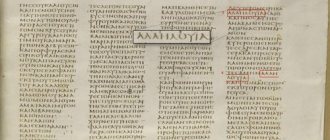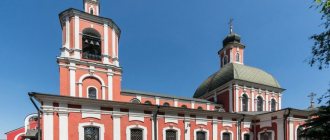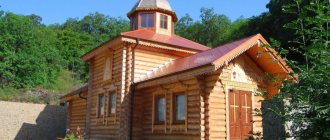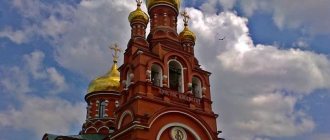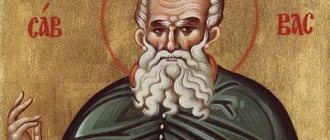The history of the Cathedral of Christ the Savior is inextricably linked with the history of the country. Having defeated the French in the War of 1812, Russia suffered heavy losses. At the burial site of a large number of defenders of the capital, they decided to erect a monument and build a cathedral. The Cathedral of Christ the Savior in Moscow was built, destroyed and rebuilt. He rose like a Phoenix along with the revival of faith and Christianity in the country.
Currently there are tours of the building. On the observation deck there are telescopes and you can see all of Moscow, to the outskirts. During Easter and other solemn services there is a live broadcast.
Architectural and cultural landmarks
According to the plan, the Cathedral of Christ the Savior was supposed to symbolize the connection of the Almighty with Orthodox people and demonstrate the unity of God in his three hypostases. The project included three completed independent buildings on a single foundation. Currently, the Cathedral of Christ the Savior is the largest in the CIS. It has three levels - symbolizes the triune god.
The Church of the Transfiguration is located in the lower church. It stands on the site of the former Alekseevsky convent, which was demolished when the site was cleared. The cathedral has three altars:
- big - main, in honor of the Transfiguration of the Lord;
- the first small one in honor of the man of God Alexy;
- second chapel of the icon of the Mother of God of Tikhvin.
The lower church was consecrated on August 6, 1996.
The upper temple of the Savior has three altars, consecrated:
- in the name of the Nativity of Christ;
- southern in honor of St. Nicholas the Wonderworker;
- northern in honor of Prince Alexander Nevsky.
The consecration took place in August 2000.
In the stylobate - domed part of the cathedral there are:
- refectory chambers;
- Hall of Church Councils;
- temple museum;
- Hall of the Supreme Council of Churches;
- service and technical premises.
On the lowest level under the temple there is a parking lot for 305 cars and a car wash.
There are galleries along the perimeter of the building. On their walls there are memorial plaques and copies of documents related to the Great Patriotic War of 12. To the left of the entrance is the text of the Highest Manifesto, published on June 13, 1812. He announces the entry of the French army into Russian territory. Nearby is an Appeal to the Russian people on the creation of a militia, signed by the Tsar on July 6 of the same 1812.
Further on the walls of the gallery there are memorial plaques describing 71 battles that took place during the war with the French on Russian territory. They contain the following information:
- date of the battle;
- name - where it happened, the nearest city or other locality;
- types of troops taking part, their number;
- list of killed and wounded officers;
- How many people were out of action?
A row of boards runs along the perimeter of the building and ends in the gallery on the western side with manifestos: about the expulsion of Napoleon, thanks to the Russian people and separately to the nobility who stood up for the defense of the Fatherland.
To the right of the entrance to the galleries, a manifesto on the construction of the Cathedral of Christ the Savior and a plaque describing 87 battles in which Russian troops participated on the road to Paris. The memorable series is completed by the manifesto on the overthrow of Napoleon and the capture of Paris. Above each memorial slab there are glorifications of saints, whose memory is celebrated on the day of the battle.
The cathedral is a monumental multifunctional building. It contains:
- a museum of ecclesiastical art with artistic works dating back to the 15th century;
- Church Cathedral Hall for 1300 seats;
- halls in which shrines are kept;
- refectories united into one hall;
- octagonal iconostasis opposite the main entrance;
- Observation deck.
10 thousand people can attend the service at the same time.
When creating the decoration of the Cathedral of Christ the Savior, 50 kg of gold was spent on ornaments alone. The main compositions “The Entry of the Lord into Jerusalem” and “The Baptism of the Lord” were designed and performed by Vasily Nesterenko. The group for painting the chapel of St. Nicholas was led by Professor Sergei Repin. The artists painting the chapel of Alexander Nevsky were led by Alexander Bystrov.
The composition “Fatherland” decorates the domed space. Above the image it depicts the Holy Trinity: God the Father, Jesus Christ the Child and a dove - the Holy Spirit. The Mother of God and the Savior are painted on the belt. The group of artists creating the images of the saints and finishing the dome was led by Zurab Tsereteli.
INTERESTING: Prayer to Jesus Christ for help and protection.
The pylons of the temple are decorated with paintings from the earthly life of Christ. The main compositions are the “transfiguration of the Lord” and the moment of ascension. Under the high arches of the cathedral, the iconostasis looks like an octagonal Kremlin protected by domes. It represents an independent architectural element, harmoniously combined with the surrounding hall.
The original architectural solution allows three refectory rooms located nearby to be combined into one on holidays and special days.
The main shrine of the capital
The most beautiful view of the monastery is available from the Patriarchal Bridge. From this angle, all advantageous points of the building are revealed. Nothing will interfere with your view. Please note that the Patriarchal Bridge is also one of the main attractions of Moscow. It is considered pedestrian and stretches across the Moscow River. Further, the structure stretches to Bolotny Island and crosses the Vodootvodny Canal. The bridge was designed by the architect M. Posokhin. The artist Z. Tsereteli and engineers A. Kolchin and O. Chemerinsky also worked on the sketches. The opening date is 2004.
The beautiful property amazes with the splendor of its 12th century architecture. By the way, the Cathedral is designed in the same style. At night, an incredibly beautiful backlight turns on. Lamps of unusual design were installed. It is noteworthy that they are mounted directly into the bridge deck. Walking along the Patriarchal Bridge, you can enjoy the majesty of the Cathedral of Christ the Savior and take some beautiful photographs. Lovers here love to make dates and organize leisurely walks. For those getting married, there are places for “love locks”. Today there are already a great many of them here and they are only getting bigger every week.
There is a beautiful tradition of releasing pigeons from the bridge. It was here that the New Year's addresses of the President of the Russian Federation were recorded against the backdrop of the cathedral. Also from here other objects are available for viewing - the Red October chocolate factory, the monument to Peter the Great, a magnificent view of the Moscow River and much more. Be sure to stay here to admire the capital's cityscapes. On the other hand, you will see Red Square, the Kremlin embankment, the Kremlin Palace, the Annunciation and the Archangel Cathedrals.
After crossing the bridge, you come to the mighty building of Christ the Savior. This is the largest cathedral in Russia. It can accommodate up to 10 thousand people. The external design delights with its richness. Immediately I see golden domes and high reliefs made of marble. The temple complex is represented by four domes. Grand or Solemn is the largest. Its weight reaches 29.8 tons. Its ringing is heard 4 times a year. It operates on the four most important Orthodox holidays. The holiday bell rings on the days of the Twelve Feasts.
Architecture and interior decor
The design of the building is monumental. The golden domes are clearly visible from various points in the capital. This was the authors' intention. The fact is that the object has an advantageous position. It is located right on the hill. The view of the shrine is special from different angles. She is incredibly beautiful, so you want to admire her endlessly.
The cathedral is equipped with several entrances and exits. The central one is located on the side of Volkhonka Street. It is from this point that it is convenient to get to the temple. Admission is free. Therefore, anyone can come here. Passage is carried out through metal detectors. This measure was made for the safety of parishioners. Filming and photography is not allowed. A penalty is imposed for the action. Therefore, photographs of the interior decoration are presented in small quantities.
This grandiose Orthodox construction project in the history of Russia embodies the ideas of domestic and world art. The building is shaped like a square superimposed on a cross. This is ensured thanks to the corner pylons. The central tower has four spectacular projections. In total there are about 14 bells installed. Their total weight reaches 64 tons. From a distance the building looks solemn and elegant. The closer you come to it, the more you feel its monumentality. There are 20 arches at the bottom. They are slightly pointed towards the top. This element gives the building a certain rigor. The western facade is considered to be the main one. The imperial patrons are depicted on the sides. On the arch of the gate you will see beautiful angels with open wings.
The southern side of the temple indicates the direction where great battles with important decisions took place in Rus'. The images on the walls are directly related to the Great Patriotic War. Below, towards the arches, there are images from the Old Testament. The eastern facade is directed towards the Kremlin. The northern façade is painted with images of national saints.
There are bronze sculptures at the entrance gate. They were made according to the sketches of F. P. Tolstoy. The porch is extremely beautiful. Its porches are made of fine-grained granite. The color of the material is dark red. Thus, the result of the considerable work of the craftsmen is the solemn, bright, original design of the building. The space under the dome is decorated no less unusually. Thus, in the central part there are mainly images of God, the earthly part is made with scenes from the life of Christ on earth. At the intersection of the two sides you will find icons of the Mother of God and saints.
The iconostasis is unique. It was made in the form of a white marble chapel consisting of eight corners. Its height reaches 26.6 meters. The main altar is painted with sacred paintings. There are many bronze figures, silver utensils, luxurious chandeliers and other interior elements all around.
The interior decoration is luxurious. The walls are high and feature vaulted ceilings. They are decorated with paintings with biblical and mythical scenes, there are many paintings and images of saints. The predominant colors are burgundy, red, green, and gold. The monastery consists of many halls. At the entrance you can visit trade and souvenir shops.
There is a museum at the temple. You can visit it for free. Here are materials that reveal the history of the construction of the facility. The cathedral went through many turning points. There were both ups and downs. There are many exhibits dedicated to the Great Patriotic War. The Gallery of Military Glory is represented by a marble plaque. All event dates are presented in chronological order.
You want to admire the wealth and luxury of the interior design for as long as possible, it’s so original and catchy. The interior decor fully corresponds to the status of the shrine.
Shrines and icons of the Cathedral of Christ the Savior
The Cathedral is of great importance for the Orthodox. This is emphasized by the luxurious decoration of the walls and arches of the galleries, halls and facade. Porphyry, marble of different colors, labradorite and gold leaf were used for decoration. The photo below shows what the Cathedral of Christ the Savior looks like inside. The dome, walls and arches are painted with paintings depicting incidents from the earthly life of Christ, his resurrection and ascension to heaven.
In the lower part of the temple, in the gallery of heroes, there are marble tablets with the names of people whose contribution to the construction of the greatest structure was especially significant.
Miraculous icons are constantly kept in the Cathedral of Christ the Savior. Among them: five icons of Moscow saints, the image of the Smolensk Mother of God, the ancient Savior not made by hands, the revered face of St. Nicholas the Wonderworker. From time to time, shrines brought from Mount Athos are displayed in the temple.
Among the relics permanently kept in the temple is a fragment of Christ's robe. The temple keeper is sure that the small fragment was given to one of the soldiers during the crucifixion of Jesus. A piece of chiton is placed in a special lectern and located away from the rest of the relics. On the Feast of the Robe of the Lord - July 23, a fragment of Christ's robe is taken out and shown to the parishioners. The relic was transferred to the cathedral in 2007. Before that, it was kept in the Yaroslavl Museum, where it was discovered in the exhibit storage room in 2002.
Nail of Christ the Savior. An authentic piece of iron, weighing 80 grams and 14.5 cm long, with which Jesus was nailed, came to Russia in the 18th century. The nail was kept in the Kremlin Museum for a long time, then was given to the church and placed in the Cathedral of Christ the Savior.
A piece of Our Lady's robe. Before the Assumption, the Virgin Mary bequeathed her tunic to the widows who served. Part of the Virgin's robe was kept in the Holy Land. She was kidnapped in the 5th century and transported to Constantinople. In the 17th century, the shrine came to Russia. It was packed in a lectern and kept, like most sights, in the Kremlin Museum. In 2008, the relic was presented to the Russian Orthodox Church and was placed among other shrines of the Cathedral of Christ the Savior.
Metropolitan Philaret was remembered by his contemporaries for his nobility and Christian humility. He became famous for his theological works and activities as a pastor. Filaret headed the Orthodox Church for 46 years, going through times of persecution of religion and its rise. After his death he was elevated to sainthood. Since 2006, the relics of St. Philaret of Moscow have been permanently located in the Cathedral of Christ the Savior and are available to pilgrims for veneration.
In Moscow, 200 thousand people venerated the relics of St. Spyridon of Trimifuntsky from Greece to the Cathedral of Christ the Savior in 12 days. Data about this were provided by the press secretary of the Patriarch of Moscow and All Rus' Kirill, priest Alexander Volkov.
“Today at noon, the 200,000th pilgrim entered the Cathedral of Christ the Savior, starting from the moment the shrine was located there. This makes us happy and gives us an understanding of how much Saint Spyridon of Trimythous is revered by our people.”
, Volkov said, TASS reports, noting that among the pilgrims there were believers from different regions of Russia and neighboring countries.
Let us remind you that you can venerate the relics in the Cathedral of Christ the Savior from September 22 to October 14 from 08:00 to 20:00.
/
Thursday, October 4, 2022
/ topics:
Church
|
In the Cathedral of Christ the Savior, 200 thousand Muscovites venerated the relics of St. Spyridon
The huge number of pilgrims proves how revered Saint Spyridon of Trimythous is by Russian people.
Since September 21, in the Cathedral of Christ the Savior in Moscow, about 200 thousand people have venerated the relics of St. Spyridon of Trimythous. …..
As Volkov noted, the shrine presented in the Moscow temple is a very important spiritual relic. It is for this reason that a huge number of people wanted to see her.
“Starting from the moment the shrine was found in the Cathedral of Christ the Savior, 200 thousand people worshiped it. This gives an understanding of how much Saint Spyridon of Trimifuntsky is revered by Russian people,” the priest noted.
Let us also remind you that from October 1, the queue for the relic increased to three hours. Many witnesses note that despite the length of the queue, the number of people wishing to see the right hand of the saint increases every time. Some parishioners even bring folding chairs and stand for hours waiting.
By the way, people believe that in order to fulfill wishes or healing, it is better to venerate closer to the shrine. This way the prayer will definitely be heard. According to legends, Saint Spyridon helps in financial matters, so people often ask him to improve their financial situation.
The relics of Saint Spyridon of Trimythous, or rather his right hand, were brought to Russia from the Greek island of Corfu. They have been traveling around Russia since August 24 and have already visited 12 regions of the country. Moscow will be their last stop before being sent back to Greece.
….. The route to the temple runs along the Crimean embankment, Yakimanskaya embankment and the Patriarchal Bridge. The passage from the Kropotkinskaya metro station is closed these days.
About 200 thousand people have venerated the relics of St. Spyridon in the Cathedral of Christ the Savior since September 21
Sorry, this text is off-topic and will be removed!
About 200 thousand people have venerated the relics of Saint Spyridon of Trimythous since September 21, 2022, when the shrine was delivered to the Cathedral of Christ the Savior. …..
“This shrine, the right hand of St. Spyridon, is a very important spiritual center, to which thousands and thousands of people flock. …..
He added that people come to Moscow mainly from the regions of the Central Federal District, as well as from Ukraine and Belarus.
The right hand of St. Spyridon of Trimythous was brought to Russia from the Greek island of Corfu. Since August 24, pilgrims have bowed to her in 12 regions of the country.
Access to the shrine in the Cathedral of Christ the Savior is organized from September 22 to October 14 from 8:00 to 20:00, however, on September 21, when a solemn service took place in connection with the arrival of the ark in the capital, those present were also able to worship the shrine. …..
Over 12 days, 200 thousand people in Moscow venerated the relics of St. Spyridon
By October 4, more than 200 thousand people venerated the relics of St. Spyridon of Trimifuntsky, exhibited in the Cathedral of Christ the Savior.
“This makes us happy and gives us an understanding of how much Saint Spyridon of Trimythous is revered by our people,” said priest Alexander Volkov, press secretary of Patriarch Kirill of Moscow and All Rus'.
The shrine arrived in Moscow on September 21, and on October 14 it will be returned back to the Greek island of Corfu. Before being installed in the capital's cathedral, the ark visited more than 10 cities.
According to Volkov, people from all over the country and neighboring countries, including Belarus and Ukraine, come to venerate the relics. All the necessary information was provided to the pilgrims on a special website and on social networks.
Up to 17 thousand believers are recorded every day. Parking at the Crimean Bridge is reserved for non-residents. The entire process is organized by about four thousand specialists and volunteers.
The website of the Moscow.Center newspaper recalls that the authorities previously approved a project to create a new pedestrian zone from the Cathedral of Christ the Savior to the Yakimanskaya embankment.
The relics of St. Spyridon were collected in Moscow by 200 thousand believers
The shrine was exhibited for worship in the Cathedral of Christ the Savior.
During the 12 days of their stay in the Cathedral of Christ the Savior, 200 thousand people came to venerate the relics of St. Spyridon of Trimythous. …..
Volkov said that today at noon the 200,000th pilgrim entered the temple to venerate the relics. This, in his opinion, indicates how revered this saint is among believers.
During the stay of the shrine in Moscow, the temple was visited not only by Muscovites, but also by residents of other regions of Russia. Citizens of neighboring countries also came, in particular, there were pilgrims from Belarus and Ukraine.
Deputy Head of the Department of National Policy and Interregional Relations of the City of Moscow, Head of the Department for Relations with Religious Organizations Konstantin Blazhenov explained that 10-15 thousand people flocked to the temple every day to worship the shrine. On weekends, the number of believers increased to 17 thousand people.
Blazhenov also said that volunteers were brought in to help the pilgrims. In total, 4 thousand people helped believers.
Let us recall that the relics of St. Spyridon were delivered to Russia from the Greek island of Corfu on August 24, and on September 21 they arrived in Moscow. The shrine has already visited many Russian cities.
Photos from open sources.
Homeless people were given access to the relics of St. Spyridon in the Cathedral of Christ the Savior
The homeless were provided with access to the relics of St. Spyridon in the Cathedral of Christ the Savior. Konstantin Blazhenov, deputy head of the department of national policy and interregional relations, told reporters about this.
“Representatives of the social protection department work with us all the time, they deal with the so-called social queue - that is, pregnant women, people with diseases of the musculoskeletal system, and with infants are admitted in a simplified manner from 3rd Obydensky Lane. Social patrol also works with people without a fixed place of residence. They are asked to go to institutions where they could spend the night, take a shower - such standard work. And their access to the relics is carried out on a general basis"
, said K. Blazhenov.
…..
About 200 thousand people venerated the relics of Spyridon of Trimifuntsky in Moscow
About 200 thousand pilgrims venerated the relics of St. Spyridon of Trimythous in the Cathedral of Christ the Savior in Moscow, the head of the press service of the Patriarch of Moscow and All Rus', priest Alexander Volkov, told reporters on Thursday.
“Starting from the moment the relics were found in the Cathedral of Christ the Savior, 200 thousand people have already venerated this great shrine.”
, Volkov said.
Despite the bad weather in Moscow, a regular flow of believers come to the relics of St. Spyridon of Trimythous, he added.
“People come from different regions of Russia, but also from neighboring countries. I know that there were pilgrims from Belarus and Ukraine"
, Volkov added.
You can touch the relics of St. Spyridon in the capital until October 14; access to them is open from 08:00 to 20:00. Then, on October 15, a ceremonial farewell to the relics will take place on the Greek island of Corfu.
During its month in Russia, the ark with the relics of St. Spyridon visited Krasnodar, Yekaterinburg, Krasnoyarsk, Kemerovo, the Moscow region, Tula, St. Petersburg, Tver, Saratov, Cheboksary and Yaroslavl.
The right hand of Saint Spyridon of Trimifuntsky was delivered to the capital on September 21, on the feast of the Nativity of the Blessed Virgin Mary. The Ark was triumphantly greeted by pilgrims in the Cathedral of Christ the Savior, and the meeting was headed by Patriarch Kirill of Moscow and All Rus'.
Spyridon of Trimifuntsky is a Christian saint, revered among the saints as a miracle worker. He was born on the island of Cyprus in the village of Assia in 270. The right hand of the saint is kept on the Greek island of Corfu.
More than 200 thousand believers have already venerated the relics of Spyridon of Trimifuntsky
The shrine has been in Moscow for two weeks now, and all these days people have been going to the Cathedral of Christ the Savior. Neither rainy weather nor long waits stop pilgrims. Many come from other cities and even from neighboring countries to touch the relics of the holy wonderworker. The ark will remain in the capital until October 14, and then return to Corfu.
About 17 thousand people come daily to venerate the relics of St. Spyridon in Moscow
Every day in Moscow, from 15 to 17 thousand believers come to the Cathedral of Christ the Savior to venerate the relics of the Greek wonderworker Spyridon of Trimifuntsky, Konstantin Blazhenov, deputy head of the department of national policy and interregional relations of the capital, and head of the department for relations with religious organizations, told reporters on Thursday.
“On average, 15-17 thousand believers come to us every day. The largest flow of believers is on Saturday, when many out-of-town believers come.”
, said Blazhenov.
He recalled that on weekends, access to the relics of St. Spyridon will be carried out from the Oktyabrskaya and Park Kultury metro stations through the Krymskaya embankment. In addition, at the Crimean Bridge near the Tretyakov Gallery, parking has been organized for out-of-town buses on which pilgrims arrive.
“During the entire stay of the relics there were no serious incidents. As a rule, it takes about 1.5-2 hours for believers to stand in line, except on weekends.”
, added Blazhenov.
…..
About 4 thousand volunteers were recruited to work at the relics of St. Spyridon in Moscow
Almost 4 thousand volunteers have expressed a desire to participate and help organize the bringing of the relics of the Greek wonderworker Spyridon of Trimifuntsky to the capital, every day about 200 volunteers are at the Cathedral of Christ the Savior, the head of the youth department of the Moscow city diocese and the Orthodox Volunteers movement, Mikhail Kuksov, told reporters on Thursday.
“In organizing the bringing of the relics to the city of Moscow, the team already numbers slightly less than 4 thousand volunteers. The guys work every day from early morning until 20:00 in two shifts. Regardless of the cold weather or the conditions in which you have to work"
- said Kuksov,
He noted that every day about 200 volunteers who meet pilgrims are at the Cathedral of Christ the Savior, also in the metro and in the Muzeon park.
“The guys are working at headquarters and in all directions. Orthodox volunteers of the city of Moscow today greet all pilgrims who come to venerate St. Spyridon at a decent level.”
“Kuksov added.
According to him, this year family volunteers are also present at the offering of the right hand of St. Spyridon, when children together with their parents participate in charitable events. As a rule, they greet and treat pilgrims with tea and sweets. In addition, children help distribute icons and flowers to pilgrims in the temple.
…..
The line of people wishing to venerate the relics of St. Spyridon starts from the Tretyakov Gallery
Pilgrims stand in line to venerate the relics of St. Spyridon of Trimifuntsky in the Cathedral of Christ the Savior; the line begins from the Tretyakov Gallery on Krymsky Val, according to a website dedicated to the arrival of the shrine in Russia.
“October 6th, 15:30 - end of the line at the Tretyakov Gallery. Estimated travel time to the shrine is 6 hours."
, the message says.
From the beginning of the Tretyakov Gallery to the Cathedral of Christ the Savior is more than 1.2 kilometers, according to the Yandex.Maps service.
Believers are advised to go to the temple from the Park Kultury or Oktyabrskaya metro station.
The relics will remain in the Cathedral of Christ the Savior until October 14. …..
Believers turn to Saint Spyridon for help in solving housing problems and in financial difficulties.
The waiting time in line to see the relics of St. Spyridon in Moscow reached 3.5 hours
Believers will have to spend about 3.5 hours in line to venerate the relics of St. Spyridon of Trimythous in the Cathedral of Christ the Savior in the capital on Wednesday afternoon, according to a website dedicated to the arrival of the shrine in Russia.
“The third of October, 15:30 - passage to the shrine - on Yakimanskaya embankment near the house ..... Access to them is open daily from 08:00 to .....
Homeless people can go to the relics of St. Spyridon in Moscow on a general basis
People without a fixed place of residence go to the relics of St. Spyridon of Trimythous in Moscow at the Cathedral of Christ the Savior on a general basis, Konstantin Blazhenov, deputy head of the Moscow Department of National Policy and Interregional Relations and head of the department for relations with religious organizations, told reporters on Thursday.
….. They are invited to go to the institution so that they can spend the night and take a shower. People without a fixed place of residence have access to the relics on a general basis,” Blazhenov said.
He noted that at the Cathedral of Christ the Savior there are employees of the Moscow Department of Social Protection who deal with the social queue, that is, in a simplified mode, pregnant women, people with diseases of the musculoskeletal system and citizens with breastfeeding can go from 3rd Obydensky Lane to the relics of St. Spyridon children.
…..
Schedule of services at the Cathedral of Christ the Savior in Moscow
Liturgies and all-night vigils are celebrated in the Cathedral of Christ the Savior on Sundays, as well as on Great Holidays.
Polyeleos services and prayer services are held in the Church of the Transfiguration on weekdays.
Throughout the summer, ordinary services are held in the church-chapel of the Icon of Our Lady “Sovereign”.
Patriarch Kirill blessed the removal of the Lord's Robe on the last Saturday and Sunday of the month, after the Divine Service, so that Christians could worship it.
During the holidays, there is a live broadcast from the cathedral and every lay person can attend the service online.
Time travel
Our ancestors built temples to the Savior and the Most Holy Theotokos in gratitude for the gracious help in life, for the miraculous salvation from death, for the granting of victories in battles with enemies.
Pages of history
During the Napoleonic invasion of 1812, 200 thousand Russian soldiers laid down their lives on the battlefields. After the end of the war, army general Mikhail Ardalionovich Kikin proposed to the emperor to perpetuate the victory of the Russian people, their courage and heroism.
On December 25, 1812, the tsar issued a manifesto ordering the construction of a church “in commemoration of gratitude to the Providence of God, which saved Russia from impending destruction,” in honor of Russia’s victory over Napoleon’s army. The temple being built, according to the emperor, should be distinguished by its grandeur and spiritual idea.
The Russified Swede, artist and architect Alexander Lavrentievich Vitberg, guessed the emperor’s desire, proposing to build a grandiose cathedral. Witberg's plan is impressive: 600 giant columns made from captured cannons, a 106-meter-long main staircase, a tomb for Russian soldiers with a building height of 170 meters and semicircular galleries, each of which is 640 meters long. The church was to be decorated with monuments to monarchs and prominent commanders, captured weapons obtained in battles with the French.
The project delighted the emperor: the site chosen for construction on the Sparrow Hills was located between the Smolensk road, along which the French entered Moscow, and the Kaluga road, along which the enemies fled from Moscow. 48 bells would signal the beginning and end of the service.
Attempt to build a temple
On the fifth anniversary of the expulsion of the French from Moscow on October 12, 1817, the foundation stone of the temple was solemnly laid. When designing, the young architect did not take into account the peculiarities of the soil, which collapsed and sank under the weight of the foundation.
Construction was delayed, groundwater and landslides disrupted the construction. In 1825, work was stopped. Vitberg’s project was considered unsuccessful and, accused of embezzlement of public funds, he was sent into exile in Vyatka.
The whole world
Emperor Nicholas I, who took the throne in 1832, entrusted the creation of a new project to the architect Konstantin Andreevich Ton with a proposal to build a church on a different site. They decided to build a new temple not far from the Kremlin on the banks of the Moscow River and for this purpose the Alekseevsky Convent was dismantled .
According to legend, the abbess of the doomed monastery refused to leave the monastery and chained herself to an oak tree. By special order of Nicholas I, the tree was dug up and, together with the abbess, moved to another place. Then she cursed the temple that would be on the site of the monastery, and predicted that it would only stand for 50 years.
On the day of the 25th anniversary of the Battle of Borodino, September 10, 1839, in the presence of the imperial family, a new temple was solemnly laid on the banks of the Moscow River. All of Russia collected money for construction, although a lot of funds came from the treasury. It took 44 years to build, and on May 26, 1883, in the presence of Alexander III and his family, it was consecrated, giving it the name of cathedral.
The word “cathedral” literally means “the place where the bishop sits.” For ease of administration, the territory of the Russian Orthodox Church is divided into regions (dioceses). Each diocese has a leader - bishop, archbishop, metropolitan - who serves in his cathedral. And the representative of the entire church - the Patriarch - serves in the main cathedral of the country.
New temple
The cathedral turned out great. Sculptures and paintings, icons and bas-reliefs, carvings and castings - what kind of talents people used to perpetuate the memory of their valiant ancestors and give praise to God! Vasily Surikov and Ivan Kramskoy, Vasily Vereshchagin and Henryk Semiradsky, Alexey Korzukhin and Fyodor Bruni worked on the painting of the temple, whose area is 22 thousand square meters (9 thousand gilded).
400 kg of gold were spent on gilding the domes . High relief statues of saints were made by sculptors Anton Ivanov, Nikolai Ramazanov, Alexander Loganovsky. Sculptor Peter Klodt is the author of the temple’s sculptural compositions.
The names of war heroes were inscribed in gold letters on marble plaques in the lower gallery. Composer Pyotr Ilyich Tchaikovsky wrote the patriotic overture “1812” for the consecration of the temple, timed to coincide with the coronation of the new Emperor Alexander III.
After the consecration, a state award was approved - the medal “In memory of the consecration of the Cathedral of Christ the Savior,” which was awarded to those who designed and built it.
The cathedral, the construction of which cost the treasury 15 million rubles, played a significant role in the socio-religious and cultural life of the capital of the Russian Empire. The new cathedral soon became a symbol of Moscow. The conductor of the choir of the Cathedral of Christ the Savior in 1918-1922 was A. V. Alexandrov, the author of the music for the anthem of the Soviet Union and the modern anthem of Russia.
Museum in the temple
The Patriarchal Museum of Church Art is located in the temple. In it, visitors are shown cultural objects, unique in their origin, associated with Orthodoxy. Including the miraculously preserved foundation board of 1839, parts of memorial slabs laid during the first construction of the temple.
Admission to the Museum of the Cathedral of Christ the Savior is free; you can only go with a group accompanied by a guide. Experienced guides will show you all the exhibits in half an hour, show you the interior of the cathedral and take you to the observation deck. The excursions are comprehensive; there are no separate independent trips to the museum.
There is a playground on the lower tier of the Arts Center. It hosts concerts of church singing, exhibitions and lectures. You can enter the hall yourself.
Miracles of St. Nicholas
During his lifetime, the saint committed many deeds that spread rumors about him throughout the world. First of all, he is considered the protector of sailors and travelers. This is due to the fact that in the biography of Nikolai Ugodnik there are many stories about his rescue of sailors. One day he resurrected a sailor who had fallen to his death from a mast. Another time, the saint did not allow a traveler to board the ship, seeing that he would die during a storm. Nicholas is also credited with numerous cases of pacifying the elements.
Often it is this saint that young unmarried girls who dream of starting a family pray to. Nicholas is considered the patron saint of girls, because during his lifetime he saved three sisters who did not have a dowry from shame. They were raised by one father, who was very sad that his daughters would have to earn a living with their appearance. After all, without a dowry, no one will ever marry them. Hearing his speech, Nikolai threw a bag of money onto his porch. This allowed the happy father to marry off the eldest of his daughters. When the middle one grew up, a bag of gold appeared on the man’s porch again. And she quickly found herself a husband. When the time came for the third sister to get married, her father began to watch at night for the benefactor who was helping their family. One night, he saw Nikolai leaving money on the doorstep. But he asked the man not to reveal his secret to others.
In addition to the benefits already listed, the saint became famous for treating the sick, protecting orphans and the oppressed, and caring for those who were unjustly condemned or accused.
Hall of Church Councils
A building unique in its architecture and design. The hall of church cathedrals seats 1,300 spectators. It was opened in 2008 to host various meetings and meetings of church leaders. Currently, it hosts many religious events of varying themes and scope. Church choirs and orchestras regularly perform in the hall. You can go to the concert for free. Conferences and meetings are by invitation only.
A unique temple on the ceiling adorns the starry sky. At its center is the main theme of the New Testament - the composition of the descent of the Holy Spirit on the apostles. On the sides of the picture there are images of the heavenly and earthly cities.
The vault is supported by four powerful round columns. They contain portraits of saints who lived in Russia, soldiers of the Lord, and statesmen.
The foyer with a winter garden, mini-waterfalls and statues of marvelous animals is not separated from the hall. Due to this, lateral acoustics are created in the hall and a pleasant microclimate is maintained.
There are comfortable chairs in the church council hall. From any place you can clearly see and hear what is happening on stage.
Observation point at the Cathedral of Christ the Savior
In the stylobate part of the temple there is an external balcony, or rather 4 platforms located between the temple bell towers, equipped as an observation deck. The floor is located at a height of 40 meters from ground level. From them you can clearly see not only the Patriarch's Ponds, the Kremlin embankment, the Moscow River with the Bolshoy Kamenny Bridge. The cathedral was built with the expectation that the entire capital, to its outskirts, would be visible.
The observation deck is safe. It is fenced on all sides with wrought iron railings and has a canopy. But you will have to climb it on foot. Visitors are not allowed to enter the site on their own. Only together with excursions. From the heights of the balconies you can see all the power and beauty of the capital, the stages of its development and construction.
Excursions
The lower galleries are free to visit. All other attractions are shown during the tour. The groups are accompanied by a guide. You must first buy a ticket. You can choose a convenient time for the excursion and order a ticket through the website of the Cathedral of Christ the Savior.
Those who wish can go up to the observation deck along with the excursion and spend 30 minutes there, having paid for this event in advance.
An excursion to the Cathedral of Christ the Savior costs from 350 rubles. The price depends on the route, internal attractions visited, and the number of people in the group.
Territory of the monastery
After visiting the shrine, take some time to stroll around the temple complex. It consists of its own Cathedral of Christ the Savior, Church of the Transfiguration, chapel, foundation and a small excursion bureau.
The Transfiguration Church of the Cathedral of Christ the Savior was built in tribute to the memory of the Alekseevsky Monastery. He was once in this place. The interior decoration is made in the spirit of the period when the monastery stood on these lands. It was the 16th century. The church consists of three altars and has two small limits. People come here to pray to the images of Alexy the Man of God and the Tikhvin Icon of the Mother of God. The church was opened and illuminated on August 19, 1996. The main asset is the icon of the Savior Not Made by Hands by artist Sorokin, which survived the destruction of the complex. Also kept here are the ancient icon of the Mother of God of Smolensk and the icon of St. Nicholas.
The chapel was erected in honor of the Sovereign Icon of the Mother of God. It is small in size and made of wood. The building is located somewhat remote from the main building. The main shrine is the “Sovereign” icon of the Mother of God. It was brought to these places in the 20th century. In modern Russia, the image is highly revered.
If you walk a few meters from the icon, you will see another beautiful building. This is the house of the famous Pertsov. The building is located right at the junction of Soimonovsky Proezd and Prechistenskaya Embankment. The facility was built in 1905-1907. Architects N.K. Zhukov, B.N. worked on the project. Schnaubert. The sketch was created by the then popular artist S.V. Malyutin. He is known throughout the world as the author of the Russian nesting doll and sketches in folk tales.
The building was built in the style of modern. However, the balconies have a distinct Old Russian style. There are also motifs from Western medieval culture. The decor of the facade is notable for its funny mythical images. Fairy-tale creatures, unusual animals and plants are skillfully depicted on the walls. The windows and walls have a lot of carved decoration. Thus, before the eyes of the observer there appears a kind of mansion house, which can be looked at indefinitely. The red object harmoniously fits into the overall picture of the capital, acting as a spectacular decoration of the street. Tourists cannot pass by an interesting object without taking a few photos.
The Foundation of the Cathedral of Christ the Savior acts as the governing body of the monastery. Its main activities are aimed at attracting philanthropists, collecting donations, organizing reconstructions, exhibitions, events and excursions. The organization's work has been carried out on the basis of a Trust Management Agreement since 2004. Externally, the building is unremarkable. The foundation specializes in conducting a variety of excursions.
Parishioners come to get acquainted with the interior of the temple, its history, and if desired, they can go up to the observation decks. From a high point there is a dizzying view of the outer suburbs of Moscow. No tourist wants to miss this opportunity. Therefore, there are always quite a lot of people who want to climb. Today, the following excursion routes are available: “High reliefs of the Cathedral of Christ the Savior”, “Paintings of the gallery of the Lower Temple (parables)”, “Exit to the observation deck”. It is possible to combine several excursions. The cost is reasonable and starts from 400 rubles. The walk is carried out in groups of 400 people. More detailed information can always be found on the official website of the monastery.
Opening hours
There is a museum inside the temple. It is open daily until 17:00. On Monday from 13-00, other days from 10-00.
The Church of the Transfiguration welcomes guests from 8 a.m. to 7:30 p.m. During services in the Cathedral of Christ the Savior, it is closed.
Excursions to the Cathedral of Christ the Savior are organized. It is easy for a lone tourist to get lost in the huge cathedral.
On the website and on the street next to the temple there is a poster of events that the laity can attend and a brief overview of them.
A few words about the saint
Nikolai Ugodnik is revered by believers all over the world. People come to him with various problems and requests. It is believed that during his lifetime the saint was so kind that he helped everyone who needed it. Naturally, even after death he continues to listen to the prayers of believers and guide them on the true path.
It is known that Saint Nicholas lived around the fourth century AD. His parents waited a very long time for the Lord to send them a child, and constantly prayed about it. At the end of their lives, God heeded their requests, and an extraordinary boy was born. Surprisingly, almost immediately after his birth he began to work miracles. For example, during baptism, the baby stood up on his feet and stood in this position throughout the entire ceremony.
Nicholas devoted all his time to the Holy Scriptures. He was so religious and pious that he practically did not leave the walls of his house so as not to spend time in idleness. Very soon they began to turn to him for advice, and the boy never refused it to anyone who asked.
The boy's uncle, seeing his nephew's religious zeal, advised him to give him up to serve God, which was done. Young Nicholas very quickly received the rank of priest, and then became the bishop of the city of Myra. Some descriptions of the saint’s life indicate the fact that, thanks to a heavenly sign, the clergy immediately elevated the young man to the position of bishop. Historians do not dispute this version, because in those distant times this was quite possible.
Nikolai Ugodnik devoted his entire life to serving God and people. He was and is considered an intercessor for souls before the Creator, and prayers to him carry enormous power.
Hotels near the Cathedral of Christ the Savior in Moscow
Staying next to the Cathedral of Christ the Savior, a city visitor will be able to explore most of the historical and architectural sights of the capital on foot.
The closest hotels to the cathedral:
- Moscow Point – Red October, distance to the temple 410 m;
- Great Hotel Mokhovaya Moscow, located 770 m;
- Park inn by Radisson Sadu is one kilometer away;
- The Arbat Hotel is 1200 m away.
In addition to these hotels, there are many others, as well as capsule hotels, separate apartments for several days for visitors.
WE RECOMMEND: Prayers to the Lord Jesus Christ.
Church of the Savior on the map of Moscow
The Cathedral of Christ the Savior is easy to find on the map. It occupies an important place in the historical old Moscow.
MoscowMoscow — Yandex.Maps
Metro to the Cathedral of Christ the Savior
There are three metro stations close to the temple:
Lenin Library:
MoscowYandex.Maps
Borovitskaya:
MoscowYandex.Maps
Kropotkinskaya:
MoscowYandex.Maps
From the first two dogas to the cathedral it takes less than 15 minutes. For passengers on the red metro line, it is enough to walk a hundred meters from the Kropotkinskaya station.
Ground transportation
You can also get to the temple by land transport. Buses, trolleybuses and taxis stop nearby.
